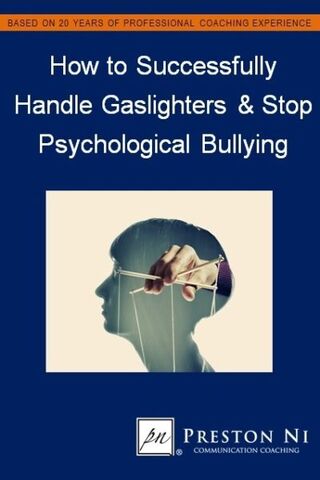Gaslighting
Gaslighting: How It Manipulates Relationships
How gaslighting controls, dominates, and exploits relationships.
Posted July 9, 2017 Reviewed by Jessica Schrader

“If you repeat a lie often enough, it becomes accepted as the truth.” ―Famous quotation, attributed to various sources
“Some people try to be tall by cutting off the heads of others.” –Paramahansa Yogananda
Gaslighting is a form of persistent manipulation and brainwashing that causes the victim to doubt her or himself, and ultimately lose one’s own sense of perception, identity, and self-worth. The term gaslighting is derived from the 1944 film “Gas Light,” where a husband tries to convince his wife that she’s insane by causing her to question herself and her reality.
In its milder forms, gaslighting creates a subtle but inequitable power dynamic in a relationship, with the gaslightee subjected to the gaslighter’s unreasonable, rather than fact-based, scrutiny, judgment, or micro-aggression. At its worst, pathological gaslighting constitutes a severe form of mind-control and psychological abuse. Gaslighting can occur in personal relationships, with verbal, emotional, and/or physical hostility from one partner to the other; at the workplace, when a supervisor regularly and unfairly berates employees; or across an entire nation, as when commercial advertising or public figures make pronouncements that are clearly contrary to the public good.
Multiple studies and writings have focused on the phenomenon of gaslighting and its destructive impact.[1][2][3][4][5][6] Here are seven stages through which a pathological gaslighter dominates a victim, excerpted from my book, How to Successfully Handle Gaslighters & Stop Psychological Bullying. Depending on the situation, there may be variations in the order, and the number of gaslighting stages involved:
Stage 1. Lie and Exaggerate
Stage 2. Repeat Often
Stage 3. Escalate When Challenged
Stage 4. Wear Out the Victim
Stage 5. Form Codependent Relationship
Stage 6. Give False Hope
Stage 7. Dominate and Control
Below is an example of how gaslighting can rob a victim’s own perception, identity, and self-worth:
Gaslighter: “Your hair is ugly!” (Focusing on an individual’s vulnerability, or creating an issue/vulnerability where none existed previously.)
Victim: “No, it’s not!” (Victim uses own experience to initially protest/refute.)
Gaslighter: “Your hair is ugly, believe me. It’s ugly every time I see it. Many people can see how ugly it is. It’s REAL ugly ...” (Repeats and exaggerates the lie. Making “universal” statements as if an individual lie is corroborated by many others, with little or no actual evidence.)
Victim: “My friends say they like my hair.”
Gaslighter: “They’re lying to you. I’m the only one being honest with you. You should thank me for pointing this out. I give myself a lot of credit for being honest with you. Trust me: Your hair is really bad and really ugly.” (Refutes the victim’s experience and reality. Taking credit for exaggeration, thereby distorting reality further by making negative statements seem positive.)
Victim: “Well, I guess I do have some bad hair days ..." (Begins to question oneself, have self-doubt, struggle with one’s own perception and identity.)
Gaslighter: “To be really honest, the problem is with your face, and the way you dress, and the way you behave …” (Doubling down on the lie, making bigger and more false claims. Sowing confusion, keeping the victim off-balance, and gaining control.)
Victim: “What do you mean …?” (The victim, now feeling insecure, relies on the gaslighter for “facts”, reassurance, and solutions, allowing the gaslighter’s distortion to replace her or his own better judgment.)
Gaslighter: “You can actually be more acceptable and attractive if you listen to me, but you’ll need to do as I say. If you don’t do as I say, you’re just going to be more ugly … I don’t even know if I want to have a relationship with you if you don’t change! And if people ask me, I’ll have to tell them the truth about how ugly you are!” (Gaslighters claim to be the sole possessor of truth and answers to the victim’s problems. Uses just enough positive reinforcement to give the victim false hope, while at the same time utilizes coercion to bully the victim to subjugate.)
Victim: I really appreciate your honesty, thank you. Please give me a chance, I’ll prove myself to you. (The victim, afraid of being further judged, attacked, insulted, and rejected, buys into the gaslighting, thereby surrendering her or his power. A psychologically dependent/abusive relationship is formed with the gaslighter, where the gaslighter controls the victim’s point of view, feelings, behavior, and self-worth.)
Notice that in the dialogue above, the gaslighter controls the entire message, while the victim is put entirely on the defensive. By repeatedly attacking the victim, and making exaggerated and confusing claims, the gaslighter avoids having rigorous scrutiny on himself, and gets away with his manipulative machinations.
At its extreme, the ultimate objective of a pathological gaslighter is to control, dominate, and take advantage of another individual, or a group, or even an entire society. By maintaining and intensifying an incessant stream of lies and coercions, the gaslighter keeps the gaslightees in a constant state of insecurity, doubt, and fear. The gaslighter can then exploit his or her victims at will, for the augmentation of his power and personal gain.

Preston Ni is the author of How to Successfully Handle Gaslighters & Stop Psychological Bullying and How to Communicate Effectively and Handle Difficult People.
© 2017 by Preston C. Ni. All rights reserved worldwide. Copyright violation may subject the violator to legal prosecution.
Disclaimer: Communication Success posts are for general educational purposes only. They may or may not be relevant to an individual's specific circumstance.
References
[1] Calef, Victor; Weinshel, Edward M. Some Clinical Consequences of Introjection: Gaslighting. Psychoanal Q. (1981)
[2] Cawthra, R.; O'Brian, G.; Hassanyeh, F. 'Imposed Psychosis': A Case Variant of the Gaslight Phenomenon. British Journal of Psychiatry. (1987)
[3] Dorpat, Theodore L. Gaslighting, the Double Whammy, Interrogation, and Other Methods of Covert Control in Psychotherapy and Psychoanalysis. Jason Aronson. (1996)
[4] Gass, G.Z.; Nichols, W.C. Gaslighting: A Marital Syndrome. Journal of Contemporary Family Therapy. (1988)
[5] Portnow, Kathryn. Dialogues of Doubt: The Psychology of Self-Doubt and Emotional Gaslighting in Adult Women and Men. Harvard Graduate School of Education. (1996)
[6] Simson, George K. Gaslighting As A Manipulation Tactic: What It Is, Who Does It, And Why. Counselling Resource. (2011)




